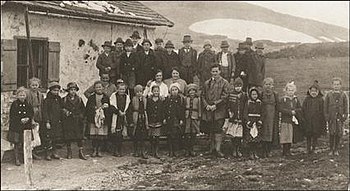Haidbauer incident

Wittgenstein (front, fifth right) with his pupils, taken in Puchberg am Schneeberg, spring 1923
|
|
| Date | April 1926 |
|---|---|
| Location | Otterthal, Austria |
| Participants |
Ludwig Wittgenstein (1889–1951) Josef Haidbauer (c. 1915–c. 1929) |
| Inquiries | Proceedings began at the district court in Gloggnitz on 17 May 1926; outcome unknown |
The Haidbauer incident, known in Austria as Der Vorfall Haidbauer, took place in April 1926 when Josef Haidbauer, an 11-year-old schoolboy in Otterthal, Austria, reportedly collapsed unconscious after being hit on the head during class by the Austrian philosopher Ludwig Wittgenstein.
Wittgenstein taught philosophy at the University of Cambridge from 1929, but a decade earlier had trained as a school teacher in Austria. It was while working at a village elementary school that the Haidbauer incident took place.
The boy's collapse was reported to the police, and Wittgenstein was summoned to appear in court in Gloggnitz on 17 May 1926, where the judge ordered a psychiatric report. According to William Warren Bartley, the hearing exonerated Wittgenstein, although Alexander Waugh writes that the outcome of the case was never published. Waugh argues that Wittgenstein's family may have had a hand in making the issue disappear.
Haidbauer was not the only pupil Wittgenstein was alleged to have struck. Ten years later, while working at Cambridge, he returned to the villages, to a mixed reception, to ask for the children's forgiveness.
In August 1918 Wittgenstein completed his Tractatus Logico-Philosophicus, first published in 1921 in Germany, and widely regarded as one of the most important works of 20th-century philosophy. After military service during the First World War, he decided to become an elementary school teacher. One of his sisters said this was like using a precision instrument to open crates.
He attended teacher-training college in the Kundmanngasse in Vienna in September 1919, and in 1920 was given his first job as a teacher in Trattenbach, a village of a few hundred about 90 km (56 mi) southwest of Vienna. He did not have a high opinion of the villagers, writing to Bertrand Russell in October 1921: "I am still at Trattenbach, surrounded, as ever, by odiousness and baseness. I know that human beings on the average are not worth much anywhere, but here they are much more good-for-nothing and irresponsible than elsewhere."
After renting a room in the attic of the local grocer's store, Wittgenstein was soon the object of gossip among the villagers, who regarded him with suspicion. Waugh writes that the brighter pupils remembered him with affection. He taught them about architecture, botany, geology, bought a microscope for them, made model steam engines, and showed them how to dissect a squirrel, and how to boil the flesh off a cat then reassemble its skeleton. Hermine Wittgenstein, his older sister, watched him teach, and said the pupils "literally crawled over each other in their desire to be chosen for answers or demonstrations."
...
Wikipedia
